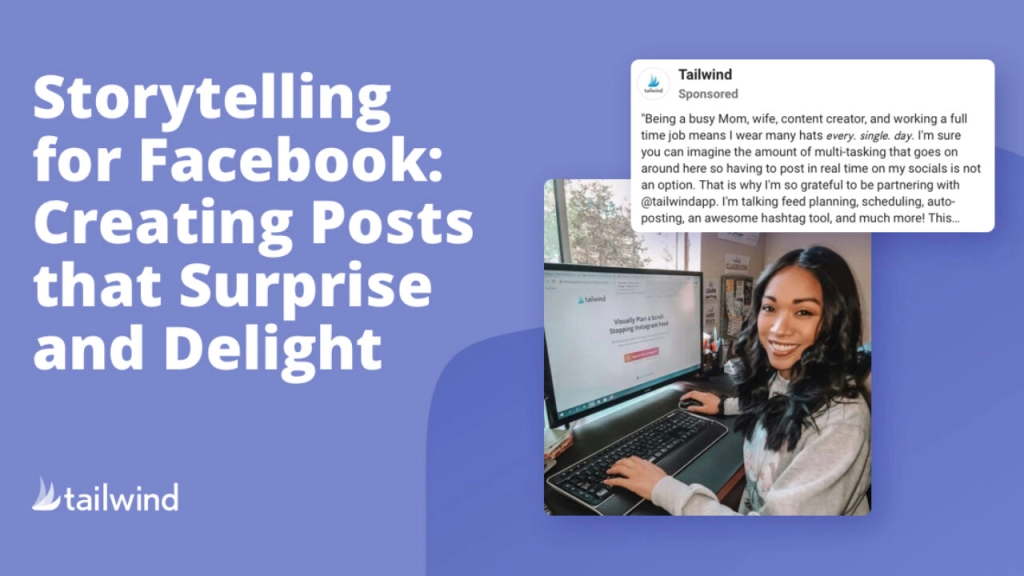We’re about to explore the fascinating realm of social media storytelling. Social media has transformed the way stories are told and shared. Think of it as a means to share your stories, experiences, and ideas with a global audience using platforms like Facebook, Instagram, Twitter, and TikTok. It’s a way to express yourself and connect with people worldwide. So join us on this journey as we discover the ins and outs of mastering social media storytelling.
Storytelling has been an essential form of communication throughout human history. It’s how we pass down knowledge, share experiences, and connect with one another.
When we hear a good story, we become engrossed, empathetic, and emotionally connected to the storyteller. The ancient art of storytelling has now found a new home on social media platforms.
In this blog, we will explore the world of social media storytelling and provide you with valuable insights and practical tips on how to do it right.
Before diving into the “how,” it’s crucial to understand the “what” and “why” of social media storytelling.
Table of Contents
What is storytelling?
If you love books, it’s okay to keep finding new ones to read. You might have some favorite authors whose books you always enjoy.
These authors are good at making stories that you like. But what’s storytelling, exactly? Is it just telling a story with lots of words?
Not quite. Stories are always a large number of words on a page.
They can be found everywhere, like in regular talks, written stuff, or even blogs online.
At the core of storytelling is the idea that a story can make people feel connected.
Here’s a simple definition of storytelling:
Storytelling is when you use real events and stories to tell a message. It’s about using words and actions to make a story interesting. It’s like a chat between the storyteller and the listener.
No matter how you tell a story, it helps people imagine the story in their heads. It’s like a movie in their mind based on the storyteller’s words and their own experiences.
What is social media storytelling?
Social media storytelling is like sharing your cool stories with your friends, but you do it on the internet! It’s a way to tell people about your adventures, thoughts, and things you love. Do you know those pictures and videos you see on Facebook, Instagram, Twitter, or TikTok? This is all part of social media storytelling. People use these pictures and videos to show what’s happening in their lives or to talk about things they care about.

Why is Social Media Storytelling Important?
Why is this storytelling stuff so important? Well, here’s why:
- Making New Friends: Social media storytelling helps you connect with people who have similar interests or who want to learn from your stories.
- Learning New Things: You can share what you’ve learned, like cool facts or how to do fun stuff. Plus, you can learn from others too!
- Expressing Yourself: It’s a bit like drawing a picture or writing in your diary but on the internet. You’ve got to show the world what’s in your heart and head.
- Personal Branding: Storytelling helps students create and develop their personal brands, showcasing their skills, passions, and personality.
- Networking: It fosters an environment for networking with peers and professionals in your chosen field.
- Influence and Impact: Well-crafted stories can inspire, educate, and influence a wide audience.
How to choose the right platform for storytelling?
The first step in social media storytelling is choosing the right platform. Each platform has its own unique features and audience, making it essential to select the one that aligns with your storytelling goals. Don’t panic! Here are some simple ways to be a good storyteller on Facebook, Twitter, Instagram, and YouTube.
Facebook Storytelling:
Facebook is suitable for longer-form stories and articles. It’s great to share in-depth personal narratives and professional insights.
So, on Facebook, there are lots of ways to share your stories. You can use words, pictures, videos, and even talk to your friends in real-time. It’s like having your own online storybook where you’re the author. Cool, right?
But remember, when you’re sharing your social media storytelling, always be safe and kind to others. Facebook is a friendly place, so let’s keep it that way!

YouTube storytelling:
For students who enjoy long-form content and want to delve deeper into their stories, YouTube offers the opportunity to create video blogs (vlogs) or documentaries.
YouTube is like your personal movie theater where you can be the director, actor, and social media storyteller all in one. With videos as your medium, you can create captivating narratives, whether it’s sharing your travel adventures, teaching a new skill, or simply entertaining your audience.
Your imagination is the limit, YouTube and YouTubeshorts is the stage where your stories come to life, engaging viewers from around the globe.
So grab your camera, unleash your creativity, and let the storytelling begin!
Instagram storytelling:
Instagram is your visual storybook, where every post is a new chapter. Through photos and short videos, you can share your daily experiences, passions, and creativity.
It’s like having a conversation through images, telling your stories at a single glance and adding some related hashtags. The best part? Your followers become part of your narrative, sharing likes and comments.
Instagram is where snapshots turn into stories, and where you can express yourself in the blink of an eye. So snap away and let your visual social media storytelling journey unfold!
Let’s look at a great example of a Fashion brand, H&M aimed to establish a connection with the demographic of young women between the ages of 18 and 34. Their objective was to generate enthusiasm for the Metaverse Design Story collection, which encompasses both ready-to-wear clothing available for online and in-store purchases and digital garments co-created with the Institute of Digital Fashion.
Twitter storytelling:
Twitter is like a book of very short stories. You have just a few words to share your thoughts, ideas, and experiences. It’s like sending a message in a bottle and hoping someone finds it interesting. Every tweet is a tiny chapter in your ongoing adventure.
So keep it short and sweet and let your creativity shine through in 280 characters or less. Your Twitter feed is your canvas for bite-sized social media storytelling!
Your hashtag doesn’t always need to trend as long as your followers grasp its purpose and use it in their tweets. Therefore, utilize hashtags efficiently with careful planning in your social media marketing strategy.
For example: Patagonia uses its social media to teach people about the environment and new tech stuff. While some don’t like ads on social media, those who care about the environment, and others are okay with seeing info about important issues. This helps Patagonia market its products without being annoying.

Crafting your story
Social media storytelling is a magical art form that weaves words and emotions together to create captivating narratives. Whether you’re an aspiring writer, a student, or just someone who loves a good tale, understanding the craft of storytelling is an exciting journey.
Here’s a simple guide to help you get started.
1. Begin with a Character
Every story has a hero or heroine, a character your audience will root for. It could be a brave knight, a curious explorer, or even an ordinary person facing extraordinary challenges. Give your character depth, desires, and flaws to make them relatable.
2. Set the Scene
Your story needs a backdrop, a place where your characters come to life. It could be a bustling city, a mysterious forest, or a distant planet. Describe the setting vividly, so your readers can picture it in their minds.
3. Plot the Journey
Every social media story has a beginning, middle, and end. In the beginning, introduce your character and their world. In the middle, show the challenges they face and the choices they make. And in the end, resolve the main conflict and provide a satisfying conclusion.
4. Build Tension
Tension keeps your readers engaged. Create obstacles and conflicts that your character must overcome. Will they succeed, or will they fail? This uncertainty is what keeps the social media story interesting.
5. Show Emotions
Emotions are at the heart of your story. Let your characters feel joy, fear, love, and anger. Make your readers connect with the characters by describing their feelings and reactions.
6. Use Dialogue
Dialogue brings your character in social media storytelling to life. It’s how they communicate, share their thoughts, and reveal their personalities. Use dialogue to advance the story and create interactions between characters.
7. Edit and Polish
Once you’ve written your story, it’s time to revise. Check for spelling and grammar errors in your social media storytelling, and ensure your sentences flow smoothly. Read your social media storytelling aloud to see how it sounds. Editing is where your story truly shines.
8. Share Your Story
Don’t keep your story hidden. Share your social media storytelling with friends, family, and even online communities. Feedback can help you improve and grow as a storyteller.
Remember, social media storytelling is a journey of imagination and creativity. So grab your pen or keyboard and let your social media stories come to life. With each tale you craft, you’ll become a better storyteller, ready to embark on new adventures in the world of imagination. Happy writing!
6 Simple Tips to Boost Your Social Media Storytelling Campaign
Talk about some fantastic social media storytelling tips to make your social media campaign a big success.
Tip 1: Know Your Audience
Before you start spinning a story, think about who you’re telling it to. Who’s going to love it the most? Understanding your audience is key to crafting an engaging tale.
A great way to do this is by creating ‘customer personas.’ They’re like story characters that help you tailor your content to the people who’ll read, listen, or watch it.
Tip 2: Build a ‘Long’ Story
When you’re sharing your business story on social media, look at both your short-term and long-term goals. Your stories need to come in all shapes and sizes, from short clips to social media posts and images.
Every piece of content you create adds to your brand story, so aim to keep your audience engaged for the long haul.
Tip:
Don’t change your themes or designs too often. It takes time for your audience to recognize and connect with your brand’s image.
Tip 3: Write like a Writer
You don’t need to be a professional writer to create a social media story that people will love. Want to grab attention? Write a story that’s creative, unique, and intriguing.
Tip:
To keep your audience hooked, throw in a cliffhanger in your headline or title. Make them want to come back for more.
Tip 4: Make Your Story Meaningful
An interesting story might get you a ‘like,’ but what really gets your audience engaged and taking action is a meaningful social media story.
When you tell a story that deeply matters to your audience, it stirs their emotions and forges a strong connection with your brand.
So, before you craft your story, figure out what’s truly meaningful to your audience.
Tip:
Besides entertaining your audience, make sure your social media content adds value to their lives. That’s how they’ll see the worth of your brand.
Tip 5: Utilize Social Tools
If social media storytelling feels like a tough nut to crack, there are handy tools at your disposal. Instagram stories, Snapchat stories, or Facebook stories are excellent options.
These tools make creating content a breeze. They let you craft real-time videos with cool filters and effects. If you’re aiming for a younger crowd, these tools are a goldmine for social media storytelling.
Also, don’t forget to use social media scheduling tools to keep a steady flow of storytelling content on all your social platforms.”
Tip 6: Harness the Power of Storytelling Techniques
Here are three special social media storytelling tricks that really grab people’s attention:
1. Synecdoche: This technique uses a part to represent the whole or the whole to represent a part. For instance, Airbnb tells its brand story by using customer photos and experiences. They share these stories on Facebook through posts and albums, making the Airbnb experience feel more real and enticing to others
2. Origins: This is a classic way of telling a brand’s story. It means involving your audience right from the start. You should actively engage with your audience to find out what they want to read or hear. Then, create content that matches their interests. This approach fosters genuine conversations and valuable engagement.
3. Spoilers: It’s like giving a sneak peek of the most exciting part of your story to pique your audience’s interest in reading the whole thing. Remember, your audience is a crucial part of your business. Your story won’t succeed if it doesn’t matter to them.
To truly involve your audience in your social media stories, create relatable content, communicate with them on social media, keep things fresh, and share their stories as well as your own.”
Final Thoughts
In today’s world, consumers have so many choices when they shop. This is great for them, but it also means that competition is tough for companies trying to get their attention. However, there’s good news: only a small number of businesses can really use social media to tell amazing stories that truly connect with their audience. Your goal should be to make sure your brand is one of those.

To succeed in the digital age, your brand’s story can’t just be about selling things. You have to create a strong emotional connection with your audience. The most effective stories are the ones that make people feel something, spark their curiosity, or make them feel like they belong. In a marketplace where competition is fierce, your brand’s story can be a game-changer.
It’s important to remember that it’s not only about the products or services you provide; it’s about the experiences you offer and the values you believe in. Your brand’s story should reflect its mission, values, and the positive impact it wants to have on the world.
The digital age offers you an amazing opportunity for social media storytelling, allowing you to tell your story. Social media serves as the perfect platform for your brand to shine. Through compelling social media storytelling, you can distinguish yourself from the crowd, capture the hearts and minds of your audience, and ensure that your brand is the one they consider when making choices.
So, in a world where everyone is fighting for attention, become a master social media storyteller. Make your brand’s story not just one of many, but one that leaves a lasting impression on the hearts of your audience. Your brand’s story has the power to make it unforgettable and irreplaceable. Embrace the art of social media storytelling and let your brand’s narrative be one that people not only listen to but also remember, treasure, and come back to.












Leave A Comment